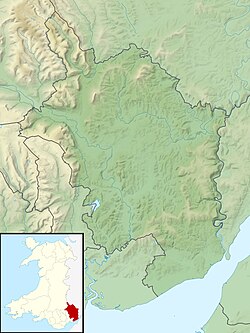Royal George House
 From Wikipedia - Reading time: 7 min
From Wikipedia - Reading time: 7 min
| Royal George House | |
|---|---|
 | |
| Type | Offices |
| Location | 5 Monk Street, Monmouth, Monmouthshire, Wales |
| Coordinates | 51°48′50″N 2°42′45″W / 51.8139°N 2.7125°W |
| Built | c. 1730 |
| Architectural style(s) | Georgian |
| Governing body | Privately owned |
Listed Building – Grade II* | |
| Official name | The Royal George Hotel (Formerly the Ivy Bank Hotel), Monk Street, Gwent |
| Designated | 10 August 2005 |
| Reference no. | 2282 |
Royal George House in Monmouth, Wales, is a large Georgian townhouse of c. 1730. Its architectural style is "old-fashioned" for its date, drawing on Carolean models such as Tredegar House. Built as a private residence, in 1800 it was occupied by the commander of the Monmouthshire Militia. In the 19th and 20th centuries the building was a hotel, first the Ivy Bank and then the Royal George. By the 1980s, it was empty and derelict. Restored, and significantly altered internally, in 1985–1987, it was subsequently a nursing home, and as of 2017 it houses commercial offices and residential apartments. It is a Grade II* listed building.
History
[edit]The house is early 18th century in date with an historical attribution to 1730.[1] Constructed as a residential townhouse, it was owned in 1800 by the commander of the Monmouthshire Militia.[2] The commander undertook significant remodelling of the house.[1] Later in the century, the house became a hotel, first the Ivy Bank and then the Royal George.[1] It was designated a Grade II* listed building on 27 June 1952.[1] In the 20th century, the hotel closed and the building suffered significant neglect.[2] It was restored 1985–1987, and was used firstly as a nursing home[2] and then as commercial offices[1] and residential apartments.[3] The building’s roof was severely damaged by fire during renovation work in 2021 and is undergoing restoration.[4]
Description
[edit]The building is of three storeys, with seven bays under a hipped roof, and was constructed "probably in the 1730s."[5] The building's façade was originally roughcast to imitate masonry and has a modillioned cornice.[6] Designed in a Carolean style, it was out of date for its time.[1]
The architectural historian John Newman, describes the building as "one of the town's finest 18th century houses."[5] The Monmouth historian Keith Kissack noted its Neoclassical interiors of about 1800,[2] introduced when the commander of the Monmouthshire Militia remodelled the house. The renovations were external, as well as internal, Newman comments on the "Adamesque Corinthian capitals and Doric frieze."[5]
Notes
[edit]- ^ a b c d e f Cadw. "The Royal George Hotel (Formerly the Ivy Bank Hotel), Monk Street, Monmouth (Grade II*) (2282)". National Historic Assets of Wales. Retrieved 18 April 2022.
- ^ a b c d Kissack 2003, p. 60.
- ^ "Royal George House, Monmouth, NP25". Rightmove.co.uk. Retrieved 3 October 2017.
- ^ Hartland, Nick (11 March 2022). "Restoration planned for fire hit Royal George". Monmouthshire Beacon. Retrieved 15 May 2022.
- ^ a b c Newman 2000, p. 406.
- ^ "Royal George Hotel (20763)". Coflein. RCAHMW. Retrieved 18 April 2022.
References
[edit]- Kissack, Keith (2003), Monmouth and its Buildings, Woonton Almeley: Logaston Press, ISBN 1-904396-01-1, OCLC 55143853
- Newman, John (2000), Gwent/Monmouthshire, The Buildings of Wales, London: Penguin, ISBN 0-14-071053-1
External links
[edit] Media related to Royal George House at Wikimedia Commons
Media related to Royal George House at Wikimedia Commons
 KSF
KSF